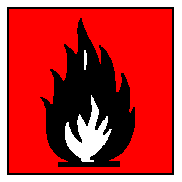International Chemical Safety Cards
| 1-CHLOROBUTANE | ICSC: 0703 |
| 1-CHLOROBUTANE n-Butyl chloride n-Propylcarbinyl chloride C4H9Cl/CH3(CH2)3Cl Molecular mass: 92.6 CAS # 109-69-3 RTECS # EJ6300000 ICSC # 0703 UN # 1127 EC # 602-059-00-3 |
 |
| TYPES OF HAZARD/ EXPOSURE |
ACUTE HAZARDS/ SYMPTOMS |
PREVENTION | FIRST AID/ FIRE FIGHTING |
| FIRE | Highly flammable. Gives
off irritating or toxic fumes (or gases) in a fire. |
NO open flames, NO sparks,
and NO smoking. |
Powder, AFFF, foam, carbon
dioxide. |
| EXPLOSION | Vapour/air mixtures are
explosive. |
Closed system, ventilation,
explosion-proof electrical equipment and lighting. Prevent build-up of electrostatic
charges (e.g., by grounding). Do NOT use compressed air for filling, discharging, or
handling. |
In case of fire: keep
drums, etc., cool by spraying with water. |
| EXPOSURE | |
|
|
| INHALATION | Cough. Drowsiness. Sore
throat. |
Ventilation, local exhaust,
or breathing protection. |
Fresh air, rest. Refer for
medical attention. |
| SKIN | Redness. |
Protective gloves. |
Remove contaminated
clothes. Rinse skin with plenty of water or shower. |
| EYES | Redness. |
Safety spectacles or eye
protection in combination with breathing protection. |
First rinse with plenty of
water for several minutes (remove contact lenses if easily possible), then take to a
doctor. |
| INGESTION | Abdominal cramps. Nausea.
|
Do not eat, drink, or smoke
during work. |
Rinse mouth. Refer for
medical attention. |
| SPILLAGE DISPOSAL | STORAGE | PACKAGING & LABELLING | ||
| Collect leaking and spilled
liquid in sealable containers as far as possible. Absorb remaining liquid in sand or
inert absorbent and remove to safe place. Do NOT wash away into sewer (extra personal
protection: A/P2 filter respirator for organic vapour and harmful dust). |
Fireproof. Separated from
incompatible materials (see Chemical Dangers). Well closed. |
F symbol R: 11 S: (2-)9-16-29 UN Hazard Class: 3 UN Packing Group: II Marine pollutant. |
||
| SEE IMPORTANT INFORMATION ON BACK | ||||
|
||||